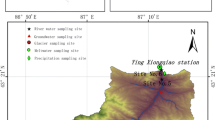Abstract
During middle June 2013, Kedarnath valley in Rudraprayag district of Uttarakhand, India, was affected by catastrophic rainfall episode that caused massive loss of human lives and damage to the properties and livestock. Isotopic signatures of rainfall, snow/ice melt water and river water of Mandakani River were measured from 25 May 2013 to 16 June 2013, and these isotopic signatures are used to estimate the contribution of rainfall-derived runoff on flooding day. The result indicates that during the course of flood in Mandakani River, isotopic signature of river water was −15.97 ‰, whereas average isotopic signature of river before the flood shows −10.39 ‰. By using the two-component mixed model, the contribution of rainfall-derived runoff is found to be 78 % and the contribution of snow/ice melt runoff is 22 % during the flash flood in Mandakani River surrounding the Shri Kedarnath Temple, Central Himalaya, India.









Similar content being viewed by others
References
Ahluwalia RS, Rai SP, Jain S, Kumar B, Dobhal DP (2013) Assessment of snowmelt runoff modeling and isotope analysis: a case study from the western Himalaya, India. Ann Glaciol 54(62):299–304. doi:10.3189/2013AoJ62A133
Ahluwalia RS, Rai SP, Jain S, Dobhal DP, Kumar A (2015) Estimation of snow/glacier melt contribution in upper part of the Beas River basin, Himachal Pradesh using conventional and SNOWMOD modeling approach. J Water Clim Change 6(4):880–890. doi:10.2166/wcc.2015.107
Asthana AKL, Asthana Harshita (2014) Geomorphic control of cloud bursts and flash flood in Himalaya with special reference to Kedarnath area of Uttarakhand, India. IJAEES 2(1):16–24
Costa JE (1987) Hydraulics and basin morphology of the largest flash floods in the coterminous United States. J Hydrol 93(3):313–338. doi:10.1016/0022-1694(87)90102-8
Craig H (1961) Standard for reporting concentrations of deuterium and oxygen-18 in natural waters. Science 133(3467):1833–1834. doi:10.1126/science.133.3467.1833
Dalai TK, Bhattacharya SK, Krishnaswami S (2002) Stable isotopes in the source waters of the Yamuna and its tributaries: seasonal and altitudinal variations and relation to major cations. Hydrol Process 16(17):3345–3364. doi:10.1002/hyp.1104
Dincer J, Payne BR (1971) An environmental isotope study of the South-Western Karst region of Turkey. J Hydrol 14:233–258
Dobhal DP, Gupta AK, Mehta M, Khandelwal DD (2013) Kedarnath disaster: facts and plausible causes. Curr Sci 105(2):171–174
Hooper RP, Shoemaker CA (1986) A comparison of chemical and isotopic hydrograph separation. Water Resour Res 22(10):1444–1454
IMD Preliminary report on heavy rainfall over Uttarakhand during 16–18 June 2013. India Meteorological Department, Ministry of Earth Sciences; July 2013; http://imd.gov.in/doc/uttrakhand_report_04_09_2013.pdf
International Panel for Climate Change, Climate Change 2013: The Physical Science Basis Report
Jain SK, Rai SP, Ahluwalia RS (2011) Stream flow modelling of Beas River at Manali, Himachal Pradesh. Proceedings of national conference on recent advances in civil engineering (RACE-2011). Baranas Hindu University, Varanasi, pp 286–289
Kotal SD, Roy Soma Sen, Bhowmik SK (2014) Catastrophic heavy rainfall episode over Uttarakhand during 16–18 June 2013—observational aspect. Curr Sci 107(2):234–245
Kumar B, Rai SP, Kumar US, Verma SK, Garg P, VijayaKumar SV, Jaiswal R, Purendra BK, Kumar SR, Pande NG (2010) Isotopic characteristics of Indian precipitation. Water Resour Res 46(12):WI2548. doi:10.1029/2009WR008592
Lakshmy PR, Midhun M, Ramesh R, Jani RA (2014) 18O depletion in monsoon rain relates to large scale organised convection rather than the amount of rainfall. Sci Rep. doi:10.1038/srep05661
Maule CP, Stein J (1990) Hydrologic flow path definition and partitioning of spring melt water. Water Resour Res 26(12):2959–2970. doi:10.1029/WR026i012p02959
Maurya AS, Shah Miral, Deshpande RD, Bhardwaj RM, Prasad A, Gupta SK (2011) Hydrograph separation and precipitation source identification using stable water isotopes and conductivity: River Ganga at Himalayan foothills. Hydrological Process 25(10):1521–1530. doi:10.1002/hyp.7912
Mrartinec J, Siegenthaler U, Osechger H, Tongiorgi E (1974) New insights into the runoff mechanism by environmental isotopes. In Proceedings of symposium organised by IAEA, Vienna. pp 129–149
NRSC; www.nrsc.gov.in and http://bhuvan.nrsc.gov.in/updates/gallery
Obradovic MM, Sklash MG (1986) An isotopic and geochemical study of snowmelt runoff in a small Arctic watershed. Hydrol Process 1(1):15–30. doi:10.1002/hyp.3360010104
Rai SP, Kumar B, Singh P (2009) Estimation of contribution of south west monsoon rain to Bhagirathi river near Gaumukh, western Himalaya, India using 18O. Curr Sci 97(2):240–245
Ramesh R, Sarin MM (1992) Stable isotope study of the Ganga (Ganges) river system. J Hydrol 139(1–4):49–62. doi:10.1016/0022-1694(92)90194-Z
Uniyal A (2013) Lessons from Kedarnath tragedy of Uttarakhand Himalaya, India. Curr Sci 105(11):1472–1474
Acknowledgments
This work was supported by the Department of Science and Technology, Government of India, New Delhi. Authors are thankful to Director, Wadia Institute of Himalayan Geology, Dehradun, India, for giving all support for research and publication of this work. Acknowledgement is due to Manish Mehta and Archana Vohra for supporting the field work. Thanks are also due to watch and ward Mr. Dhanveer Pawanr and Mr. Braham Bahadur Bhandari for the collection of samples.
Author information
Authors and Affiliations
Corresponding author
Rights and permissions
About this article
Cite this article
Ahluwalia, R.S., Rai, S.P., Gupta, A.K. et al. Towards the understanding of the flash flood through isotope approach in Kedarnath valley in June 2013, Central Himalaya, India. Nat Hazards 82, 321–332 (2016). https://doi.org/10.1007/s11069-016-2203-6
Received:
Accepted:
Published:
Issue Date:
DOI: https://doi.org/10.1007/s11069-016-2203-6




